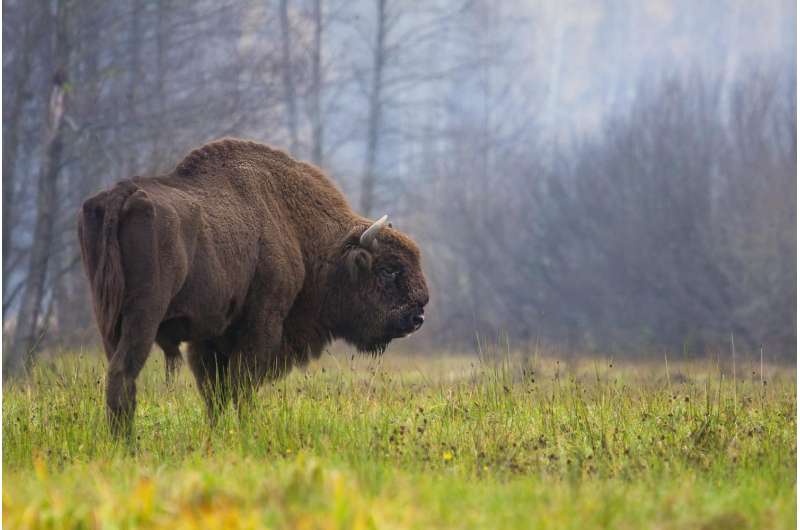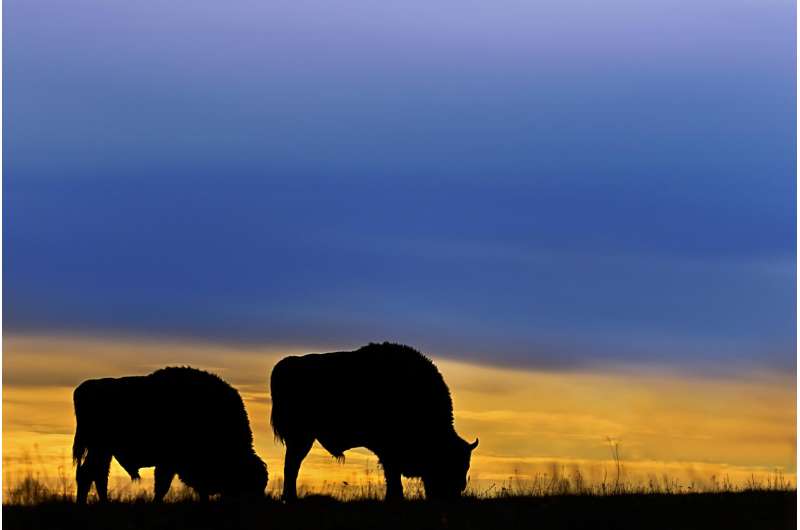Where the buffalo have evolutionarily roamed

Once almost wiped out from existence, the mighty bison has recovered to become a symbol of pride for the American West and European conversation efforts.
Now, using the first whole genome sequencing data from two European bison bulls from the Białowieża Forest World Heritage site, scientists Mathieu Gautier, Laurence Flori et al. have explored their demographic and adaptive history in comparison to bovine cousins. They estimate that the bison and bovine species diverged from about 1.7-.85 million years ago through a speciation process involving limited gene flow. Although their population sizes experienced a similar sharp decline since the Last Glacial Maximum, the authors find that the wisent demography remained more fluctuating during the Pleistocene. This suggests that wisents responded to successive glaciations by habitat fragmentation rather than southward migration.
Their comparison of the wisent and bovine genomes also revealed footprints of selection on more than 400 genes. Overall, the most significant functions associated to these genes are related to physiological functions underlying distinctive features between the bison and bovine lineages (i.e. nervous system, immune and inflammatory responses, reproduction and embryonic development, cellular morphology and organization and skeletal and muscular disorders). Among individual genes, KRT74 and DCS3 that are involved in wooly hair development and hypotrichosis, respectively and GPR50 that plays a role in thermogenesis might be directly related to wisent adaptation to colder climatic conditions.
Second, genes encoding olfactory and taste receptors are probably footprints of feeding behavior modifications, resulting e.g., from food resource differences in forest versus steppe habitat.
Finally, the European bison being the closest extant wild relative species of domestic cattle, several of the genes under selection could be associated to the physiological pathways underlying the domestication syndrome. Their results provide indeed a substantial empirical support to the hypothesis recently formulated by Wilkins and collaborators that gave a shared developmental connection, via the neural crest cells, to the different traits affected by domestication.

These genes both shed a new light on the genome response to different living conditions (temperature, available food resource and pathogen exposure) and offer new insights into the key gene functions altered by the domestication process.
The authors' approach combines inferences on the past demographic size of the species, on the mode and tempo of the separation with cattle species, and of the adaptive processes that occurred since then in these species.
"Interestingly, whole individual genome based demographic inference highlighted contrasting patterns in both species that are reminiscent of different adaptive strategies (habitat fragmentation versus migration) to survive Pleistocene glaciations," said the authors. "Our results indeed support a scenario in which wisent survive in refugee pockets during glaciations (leading to habitat fragmentation) while aurochs migrate southward (and possibly eastward) where climate remained more temperate."
Given bison are a highly endangered species, their work can potentially provide a new roadmap for future studies by other research groups.
"Although still considered as a vulnerable species, our results show that the conservation plan and subsequent management practices have been efficient to recover a reasonable amount of genetic variability that now compares to that observed in cattle breeds," said corresponding author Laurence Flori.
More generally, this work illustrates how the history of a species can be read in the whole genome sequences of a few representative individuals.
The study is published today in the Molecular Biology and Evolution.
More information: Molecular Biology and Evolution, DOI: 10.1093/molbev/msw144
Journal information: Molecular Biology and Evolution
Provided by Oxford University Press



















